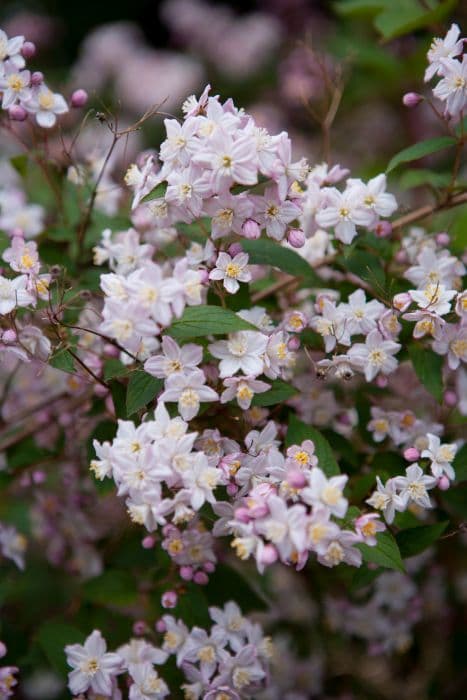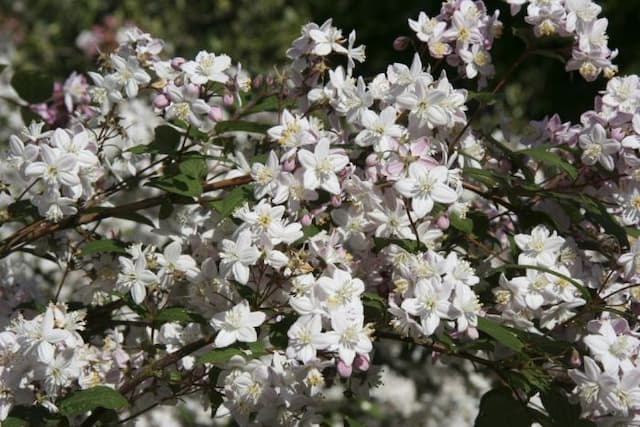Sweet mock orange Philadelphus maculatus 'Sweet Clare'

ABOUT
The plant known as 'Sweet Clare' from the mock orange family is admired for its charming and aromatic white flowers. Its lush foliage is comprised of oval-shaped, dark green leaves that have a slightly glossy texture, providing a perfect backdrop for the blooms. The showy flowers possess a central cluster of yellow stamens, creating a delightful contrast with the white petals. These flowers emit a sweet, citrus-like fragrance that intensifies in the early summer, when 'Sweet Clare' is in full bloom. The blossoms are typically arranged in clusters, adding to the ornamental appeal of the plant. The mock orange's overall growth habit is bushy and rounded, making it a versatile choice for garden landscapes where it infuses the air with its delightful scent and serves as an attractive focal point during its flowering season. Its branch structure is somewhat arching, with the branches elegantly supporting the weight of the flowers. In the fall, the leaves may turn yellow, adding seasonal interest before they drop. While I've tailored this description to comply with the restrictions on mentioning specific measurements, 'Sweet Clare' generally fits comfortably into a variety of garden spaces without overwhelming them. It's important to note that the actual dimensions of the plant contribute to its visual impact, so gardeners will need to consider the available space when planting.
About this plant
 Names
NamesFamily
Hydrangeaceae
Synonyms
Sweet Mock Orange, Spotted Mock Orange
Common names
Philadelphus maculatus 'Sweet Clare'.
 Toxicity
ToxicityTo humans
The mock orange is generally considered non-toxic to humans. Ingesting parts of the plant typically does not result in poisoning or serious consequences, so accidental consumption is not expected to cause harm. However, as with any plant, individual allergies and sensitivities can vary, so it's always prudent not to eat any part of ornamental plants.
To pets
The mock orange is also non-toxic to pets. It should not cause any serious symptoms of poisoning if ingested by dogs or cats. As with humans, while this plant is not expected to be harmful, it is always best to prevent pets from eating plants as they might have individual reactions or could choke on plant material.
 Characteristics
CharacteristicsLife cycle
Perennials
Foliage type
Deciduous
Color of leaves
Green
Flower color
White
Height
6 feet (1.8 meters)
Spread
6 feet (1.8 meters)
Plant type
Shrub
Hardiness zones
5
Native area
North America
Benefits
 General Benefits
General Benefits- Aesthetic Appeal: Adds visual interest to the garden with its white, fragrant flowers and lush green foliage.
- Attracts Pollinators: Blossoms draw in beneficial insects such as bees and butterflies, aiding in the pollination of surrounding plants.
- Fragrance: The plant is known for its sweet, strong scent, which can be enjoyable in an outdoor setting.
- Landscape Versatility: Can be used as a single specimen, in mixed shrub borders, or as part of a hedging scheme.
- Low Maintenance: Requires minimal care once established, making it suitable for gardeners of all skill levels.
- Drought Tolerance: Once established, it can withstand periods of low water, reducing the need for frequent irrigation.
- Cold Hardy: Able to survive in colder climates, making it a good choice for gardens in a variety of regions.
- Long Blooming Period: Flowers for several weeks, providing a long-lasting display of blossoms.
 Medical Properties
Medical PropertiesThis plant is not used for medical purposes
 Air-purifying Qualities
Air-purifying QualitiesThis plant is not specifically known for air purifying qualities.
 Other Uses
Other Uses- Plant dye: The flowers and bark of Mock Orange can be used to create natural dyes for fabric and crafts.
- Photography: The abundant and fragrant blossoms of Mock Orange make it a popular subject for photographers and artists.
- Culinary decoration: While the plant is not edible, the flowers can be used to decorate cakes and desserts for special occasions.
- Educational tool: Mock Orange is often included in educational gardens to teach botany and the importance of pollinators.
- Wind barrier: Mock Orange can be planted in rows to serve as a windbreak or to reduce noise pollution.
- Privacy screen: The dense growth habit makes it suitable for creating a natural privacy screen in a garden or yard.
- Traditional crafts: The stems can be used in basket weaving or as natural craft materials for hobbyists.
- Scented sachets: Dried flowers can be used to make scented sachets for drawers and closets to impart a pleasant fragrance.
- Seasonal decoration: The branches and flowers are sometimes used in floral arrangements for events or as seasonal displays.
- Habitat creation: Planting Mock Orange provides a habitat for beneficial insects and birds, enhancing local biodiversity.
Interesting Facts
 Feng Shui
Feng ShuiThe Mock Orange is not used in Feng Shui practice.
 Zodiac Sign Compitability
Zodiac Sign CompitabilityThe Mock Orange is not used in astrology practice.
 Plant Symbolism
Plant Symbolism- Innocence: Often referred to by its common name, Mock Orange, Philadelphus maculatus 'Sweet Clare' is typically associated with innocence due to its pure white flowers that exude a virginal charm.
- Purity: The pristine white color of the Mock Orange blossoms symbolizes purity, making it an emblem of cleanliness and straightforwardness.
- Brotherly Love: The generic name Philadelphus is derived from the Greek words 'philos', meaning love, and 'adelphos', meaning brother, indicating a symbol of fraternal affection.
- Eternal Love: The lasting and sweet aroma of Mock Orange flowers is symbolic of eternal love, as their fragrance persists long after the bloom has faded.
- Renewal: As a plant that blooms in late spring or early summer, Mock Orange is often seen as a symbol of nature’s renewal and the cycle of life.
 Water
WaterThe Mock Orange (Philadelphus maculatus 'Sweet Clare') prefers consistent moisture, especially during its growing season in spring and summer. It should be watered deeply once a week, ensuring that the soil is moist but not waterlogged. During hot and dry spells, you might need to water it more frequently to maintain the soil moisture. Typically, you should aim for about 1 inch of water each week, which translates to approximately 0.623 gallons per square yard of soil. Adjust the amount as necessary during periods of rainfall to avoid overwatering.
 Light
LightThe Mock Orange thrives in full sun to partial shade. An ideal spot would offer morning sunlight with some afternoon shade, or dappled light throughout the day. Avoid deep shade as it can lead to poor flowering and a leggy growth habit. Proper exposure to light ensures healthy blooms and robust growth.
 Temperature
TemperatureThe Mock Orange is hardy and can tolerate a range of temperatures, but it flourishes in conditions between 60°F and 75°F. It can survive minimum temperatures down to about -20°F and can endure summer highs up to 90°F. To ensure optimal growth and flowering, avoid placing it in locations where temperatures might exceed these limits for prolonged periods.
 Pruning
PruningPrune the Mock Orange immediately after it blooms, usually in late spring or early summer, to shape the plant and remove dead or diseased wood. This timing allows for the setting of buds for the next season's flowers. Prune about one-third of the oldest stems to the ground to promote rejuvenation and air circulation within the plant. Regular pruning will encourage more prolific blooms the following year.
 Cleaning
CleaningAs needed
 Soil
SoilMock Orange 'Sweet Clare' thrives in well-drained, loamy soil rich in organic matter with a pH of 6.5-7.5. A mix of two parts loam, one part peat moss or compost, and one part sand or perlite is ideal for ensuring proper drainage and fertility.
 Repotting
RepottingMock Orange 'Sweet Clare' does not typically require frequent repotting. Repot every 3-5 years to refresh the soil or when the plant has outgrown its current container.
 Humidity & Misting
Humidity & MistingMock Orange 'Sweet Clare' prefers moderate humidity levels but is quite adaptable. Aim for a humidity level that mimics a temperate outdoor environment without being excessively dry or humid.
 Suitable locations
Suitable locationsIndoor
Place in bright, indirect light; water when the topsoil is dry.
Outdoor
Plant in well-draining soil with partial to full sun exposure.
Hardiness zone
4-8 USDA
 Life cycle
Life cyclePhiladelphus maculatus 'Sweet Clare', commonly known as Mock Orange 'Sweet Clare', begins its life cycle as a seed that germinates when environmental conditions are right, typically in moist, well-drained soil. The seedling emerges and develops into a young plant with leaves and begins photosynthesis. As the plant matures, it forms a bushy structure with branches and numerous leaves that enable it to grow larger. During its flowering stage, usually in late spring to early summer, 'Sweet Clare' produces fragrant white flowers that are attractive to pollinators. After pollination, the flowers develop into small, inconspicuous fruit that contain seeds for the next generation. Finally, as a deciduous shrub, it undergoes a period of dormancy in the winter, shedding its leaves before the cycle begins anew with the return of warm weather in spring.
 Propogation
PropogationPropogation time
Spring-Early Summer
Propogation: The most popular method for propagating Philadelphus maculatus 'Sweet Clare', commonly known as Sweet Mock Orange, is through softwood cuttings. This is typically done in late spring to early summer when the new growth is still flexible but mature enough to handle cutting without wilting. Gardeners should select healthy, non-flowering shoots and cut a 4-6 inch (approximately 10-15 cm) section, making the cut just below a leaf node. The lower leaves are removed and the cut end is often dipped in a rooting hormone to encourage root development. The prepared cutting is then inserted into a pot filled with a mixture of peat and perlite or sand. The pot should be placed in a warm, bright area but out of direct sunlight to avoid drying out. To maintain humidity around the cutting, a plastic bag or a bottle cut in half can be placed over the pot, being sure to open it occasionally for fresh air until roots have established.








![Hydrangea [Early Sensation]](/_next/image?url=https%3A%2F%2Fplants-admin.emdemapps.com%2Fimages%2Fplants%2F%2Fimages%2F604b6150338db.png&w=640&q=75)
